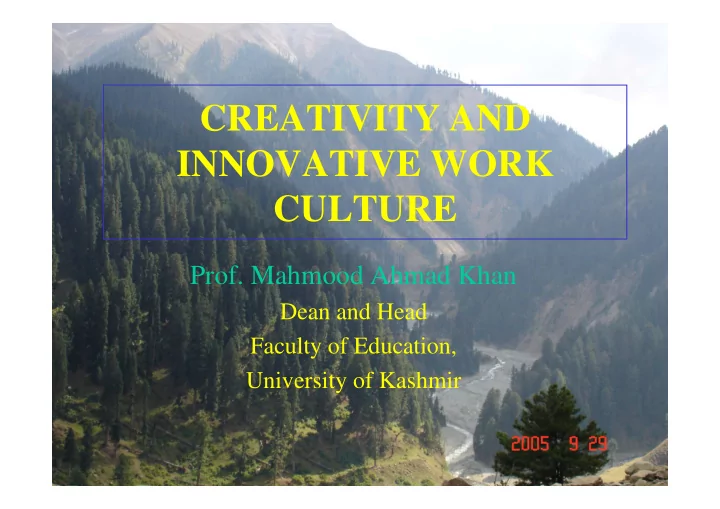

CREATIVITY AND INNOVATIVE WORK CULTURE Prof. Mahmood Ahmad Khan Dean and Head Faculty of Education, University of Kashmir
Creativity • Wertheimer (1945) Creativity as the breaking down and restructuring of thoughts about a topic to gain new insights into its nature. ‘ Productive Thinking’ . nature. ‘ Productive Thinking’ . • Rickards (1988) ‘An escape from mental stuckness'. Creativity and Innovation Yearbook .
• Proctor (1994). Creative thinking is the phenomenon of awakening new thoughts, rearranging old learning and examining assumptions to formulate new theories. ‘ Management and Creativity ’. • “The capacity to develop on original • “The capacity to develop on original product, service, or idea that makes a socially recognised contribution.” ‘Cummings Oldham (1997) California Management Review .
• Whatever is novel, unique, unconventional, original is considered creative. Creativity consists of some divergent thinking abilities . • 1. Fluency – Generate many ideas • 2. Flexibility – Variety of ideas • 2. Flexibility – Variety of ideas • 3. Originality – Generating unique ideas – Newton • Elaboration – Insight and planning ability • Sensibility – Ability to sense anomalies • Redefinition – restate problems in a fresh way - Thesis and antithesis
Stages of creative thought . Wallas (1726) The Art of Thought: • 1. Preparation – Gather date and prepare the ground for solutions. • Incubation – Contemplate on an idea to find a solution to the problem that bothers a person • Illumination – Divine gift. Poetry. Newton – • Illumination – Divine gift. Poetry. Newton – intuition. • Verification – Evaluate one’s hypothesis. Submit one self to critical appraisal. Son – Father love? Scientific temper Beginning of creativity not end
Blocks to Creativity 1. Fear of failure 2. Allergy to ambiguity 3. Fear of criticism 4. Conformity 5. Emphasis on managerial control – short term 6. Rigidity – hierarchical structure 7. 7. Myopic thinking – production, marketing, finance, Myopic thinking – production, marketing, finance, human capital 8. Lack of resources 9. Low level of motivation – Edisons 1% Motivation, 99% perspiration 10. Non-availability of time – manual labour 11. Group-think – value consensus – Mullan et al.(1994).
Innovative Work Culture 1. Brainstorming – Generate ides in response to a problem in a group. Using brain to storm a problem. Osborn (1953) [Applied imagination] T y p e s a) Stop and go 5, 8 – 5, 8 random response b) Round robin b) Round robin Turn by turns c) Buz session Different Groups, Competition, Team leader
Rules of Brain storming Don’t criticize * Provide as many responses as possible * Speak freely – wild ideas permitted, * Combine and improve ideas – team leader 2) Risk taking behaviour – norm 3) Innovative climate –top to bottom 3) Innovative climate –top to bottom 4) Positive response – innovative ideas 5) Freedom of expression – Autonomy 6) Immediate feedback 7) Provision of adequate resources 8) Exposure of employees to outside ideas – training, reading material
9) Continual flow of ideas 10. Review suggestions 11. Establish an innovative council – School different committees 12. Action research 13. Decentralisation of powers 13. Decentralisation of powers 14. Encouraging diverse opinions 15. Development of self concept 16. Self evaluation 17. Delegation of powers
18. Appraisal on week ends – feed back, interaction, permissive environment. 19. Involvement of community - enrolment - retention - Facilitation 20. Constructive controversy - Discuss the facts rather than the people 21. Optimism – Decision making
Recommend
More recommend